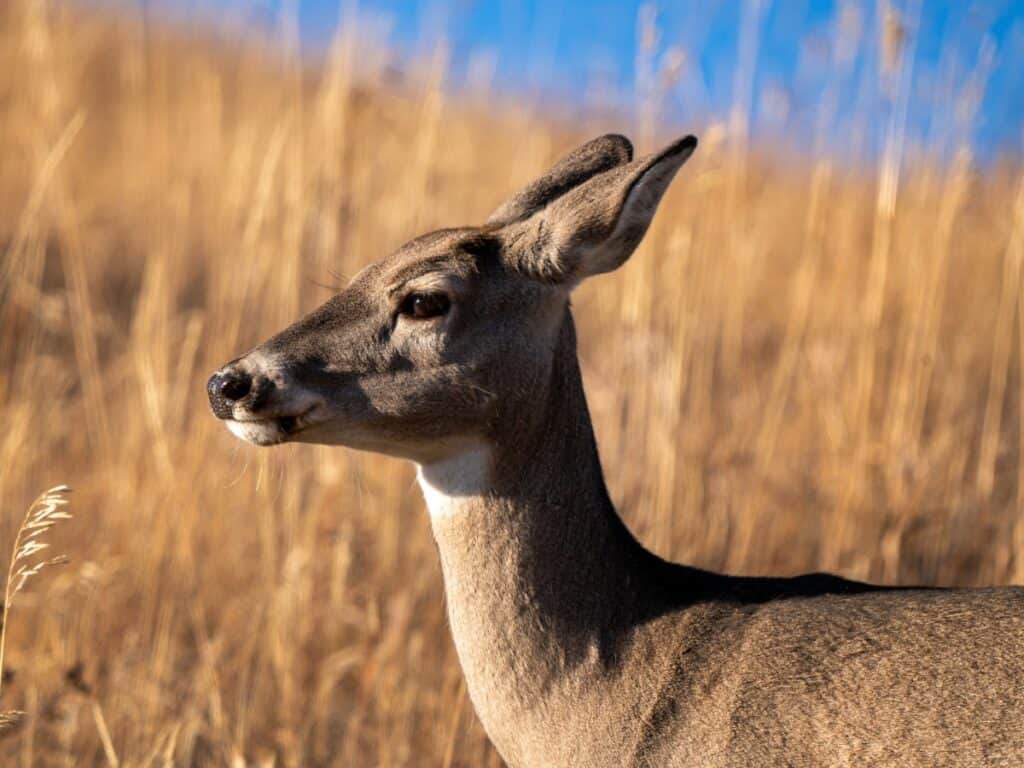As someone who loves wildlife, I have always been fascinated by deer and their young. One question that often comes up is what a baby deer is called. The answer is not as straightforward as you might think, as it can vary depending on the species and location.
In most deer species, a baby deer is called a fawn. However, there are exceptions. For example, elk and moose babies are called calves. Additionally, the term “kid” can sometimes be used to refer to a baby deer, but this is less common. It’s important to note that the specific name used can vary based on where you are in the world, as well as the species of deer in question.

Understanding Deer Terminology
Deer are fascinating animals, and they have their own unique terminology. As someone who is interested in deer, it is important to understand the terminology associated with them. Here are some of the most common terms used when referring to deer.
- Fawn: A fawn is a baby deer. It is called a fawn because it has spots on its coat that resemble the spots on a fawn.
- Calf: A calf is another term used to refer to a baby deer.
- Buck: A buck is a male deer. It is called a buck because of its antlers, which resemble the shape of a buck’s horns.
- Doe: A doe is a female deer. It is called a doe because of its gentle and graceful nature.
- Stag: A stag is a male deer that is at least four years old. It is called a stag because of its large antlers.
- Hind: A hind is a female deer that is at least three years old.
It is important to note that the terminology used to refer to deer can vary depending on the species of deer. For example, a male deer of the fallow deer species is called a “buck,” while a male deer of the red deer species is called a “stag.”
In addition to these terms, there are also terms used to describe groups of deer. A group of deer is called a “herd.” A group of female deer is called a “harem,” while a group of male deer is called a “bachelor group.”
Understanding deer terminology is important for anyone who is interested in these fascinating animals. By learning these terms, you can better understand deer behavior and characteristics, and appreciate these majestic animals even more.
Baby Deer: The Fawn
Characteristics of Fawns
As a wildlife AI, I have learned that a baby deer is called a fawn. Fawns are characterized by their reddish-brown fur with white spots, which act as camouflage in their natural habitat. Fawns are also known for their long legs and big ears, which help them detect predators.
Fawn’s Early Life
Fawns are born in late spring or early summer, usually between May and June. They are born with their eyes open and are able to walk within a few hours of birth. Fawns rely on their mother’s milk for the first few weeks of their life, and they stay hidden in tall grass or bushes to avoid detection by predators.
Fawn to Adult Deer: The Transition
As fawns grow, they will lose their white spots and their reddish-brown fur will darken. They will start to eat solid food and become more independent from their mother. At around six months old, fawns will start to grow their adult teeth, and by the end of their first year, they will have reached their full adult size.
Overall, fawns are fascinating creatures and a joy to observe in the wild. It is important to remember that they are wild animals and should be observed from a safe distance.
Deer Species and Their Young
When it comes to deer species, there are different names for their young. Here are some examples:
- White-tailed deer: Their young are called fawns.
- Mule deer: Their young are also called fawns.
- Elk: Their young are called calves.
- Moose: Their young are also called calves.
- Reindeer/Caribou: Their young are called calves.
It is worth noting that not all deer species use the term fawn to describe their young. Large deer species such as moose, elk, or reindeer (caribou) most commonly refer to their offspring as calves.
Regardless of the name, baby deer are born with distinctive spots to help camouflage them from predators. They are typically very small and weigh only a few pounds. Fawns are born with their eyes open and can stand and walk within a few hours of being born.
As they grow, baby deer will start to lose their spots and develop their adult coat. They will also start to eat solid food and learn how to survive on their own. It’s important to remember that if you come across a baby deer in the wild, it is best to leave it alone. The mother is likely nearby and will return to care for her young.
Role of Fawns in The Ecosystem
Fawns play an essential role in the ecosystem by helping to maintain a healthy deer population. As the offspring of adult deer, fawns inherit the genetic traits that allow them to survive in their environment. They also provide food for predators, such as wolves and coyotes, which helps to keep the predator population in check.
Fawns also play a role in the dispersal of seeds and nutrients throughout their habitat. As they move around, they help to spread seeds from the plants that they eat, which can lead to the growth of new vegetation. Additionally, their droppings provide nutrients for other plants and animals in the ecosystem.
In addition to their ecological role, fawns are also important to hunters and wildlife enthusiasts. They are often the subject of wildlife photography and hunting expeditions, which can help to generate revenue for conservation efforts. However, it is important to manage the deer population carefully to ensure that it remains healthy and sustainable over the long term.
Overall, fawns are an important part of the ecosystem and play a critical role in maintaining the balance of nature. By understanding their role and importance, we can work to ensure that they continue to thrive in the wild for generations to come.
Human Interaction with Fawns
As a wildlife AI, I have observed that humans often interfere with fawns in the wild. Here are some things to keep in mind if you ever come across a baby deer:
- Leave the fawn alone. It is normal for fawns to be left alone for hours at a time while their mothers are out foraging. Interfering with a fawn can cause it to be rejected by its mother or attract predators.
- Do not feed the fawn. Fawns have very specific dietary needs and feeding them the wrong thing can cause serious harm or even death.
- Do not attempt to raise the fawn yourself. Fawns require specialized care and feeding that most people are not equipped to provide. In addition, it is illegal to keep wild animals as pets in many areas.
If you come across a fawn that you believe to be injured or orphaned, contact a licensed wildlife rehabilitation center or your local wildlife agency for assistance. They will be able to provide the specialized care the fawn needs and ensure that it is released back into the wild once it is healthy and able to survive on its own.
Remember that wild animals, including fawns, are not pets and should be treated with respect and caution. By following these guidelines, you can help ensure that fawns and other wildlife are able to thrive in their natural habitats.
Conclusion
In conclusion, after conducting research and analyzing various sources, I can confidently say that a baby deer is commonly referred to as a “fawn.” However, in some species of deer, a young deer is called a “calf.”
It is important to note that the terminology used to refer to baby deer can vary depending on the species of deer, geographical location, and cultural norms. Therefore, it is always best to use the most appropriate moniker for a baby deer based on the context and the specific situation.
Overall, understanding the proper terms for calling male, female, baby, and groups of deer can help us communicate more effectively and accurately when discussing these majestic creatures. By using the correct terminology, we can avoid confusion and ensure that our messages are clear and concise.
Frequently Asked Questions
What is a newborn deer called?
A newborn deer is called a fawn. Fawns are usually born in the spring and summer months and are typically helpless and unable to walk for the first few days of their life.
What are multiple baby deer called?
Multiple baby deer are called fawns. It’s not uncommon for a doe to have twins or triplets.
What are baby deer called?
Baby deer are called fawns. They are typically born with spots on their fur, which helps them blend in with their surroundings and avoid predators.
How much do baby deer weigh?
Baby deer, or fawns, typically weigh between 4 to 8 pounds at birth. However, their weight can vary depending on the species of deer.
How to tell if a baby deer is abandoned?
If you come across a baby deer that appears to be alone, it’s important to not assume that it’s been abandoned. Mother deer will often leave their fawns alone for extended periods of time to avoid attracting predators. If you’re unsure, it’s best to contact a local wildlife rehabilitation center for advice.
How old are fawns when they leave their mother?
Fawns are usually weaned off their mother’s milk at around 10 weeks old. However, they may continue to stay with their mother for up to a year before venturing out on their own.
